#14 days nepal trek
Explore tagged Tumblr posts
Text










14 Days Everest Base Camp Trek, our group, is on the way to the Everest Base Camp. BOOKING open for autumn 🍂 2024 and 2025 spring trips. Don't miss the lifetime adventure holiday
0 notes
Text
#haven holidays nepal#nepal#holidays nepal#trekking#trekking in nepal#trek#travel#manaslu circuit trek#manaslu trek#manaslu trekking#14 days manasu circuit trek#nepal manaslu circuit trek#nepal manaslu trek#nepal manaslu trekking#manaslu circuit trekking cost & itinerary#manaslu circuit trekking in nepal#haven holidays#nepal trek#nepal travel#trekking nepal
0 notes
Text
https://www.scribd.com/document/707848280/A-Beginner-s-Guide-to-Everest-Base-Camp-Trek-Everything-You-Need-to-Know
#everest base camp trek#everest base camp trek 14 days#everest base camp trek itinerary#everest base camp trek package#nepal everest base camp trek#annapurna circuit trek#annapurna hike#annapurna trek package#annapurna circuit trek itinerary#annapurna base camp trek#annapurna base camp trek cost#annapurna base camp trek map#annapurna base camp#manaslu circuit trek#manaslu circuit trek 12 days#manaslu base camp trekking#manaslu circuit trek package#mardi himal trek#mardi himal trek cost#mardi trek itinerary#mardi himal trek package
0 notes
Text
Embarking on the Adventure: A Detailed Exploration of the Everest Base Camp Trek
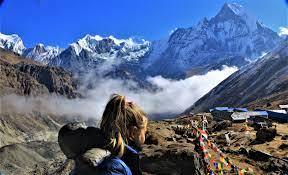
Nestled amidst the towering peaks of the Himalayas lies one of the world's most iconic treks - the Everest Base Camp Trek. This legendary journey beckons adventurers from across the globe to test their mettle against the rugged terrain and breathtaking altitudes of the Khumbu region in Nepal. From challenging trails to awe-inspiring vistas, every step of this trek is imbued with a sense of adventure and discovery. In this comprehensive guide, we delve deep into the heart of the Everest Base Camp Trek, exploring its most daunting challenges, logistical considerations, and the optimal timing for an unforgettable experience.
The Hardest Days of the Everest Base Camp Trek: Conquering the Himalayan Giants
Undoubtedly, the Everest Base Camp Trek presents its fair share of challenges, with several days standing out as particularly demanding for trekkers. Among these, the ascent to Namche Bazaar and the climb to Everest Base Camp itself are widely regarded as the most arduous.
Namche Bazaar Ascend: Situated at an altitude of approximately 3,440 meters (11,286 feet), Namche Bazaar serves as the gateway to the Everest region. The trek from Phakding to Namche involves a steep ascent, testing the endurance and acclimatization of trekkers. The thinning air and rugged terrain make this leg of the journey physically demanding, requiring a steady pace and proper hydration to mitigate altitude-related symptoms.
Everest Base Camp Ascent: As trekkers venture higher into the Himalayas, the journey to Everest Base Camp reaches its climax. The final push from Gorak Shep to Everest Base Camp involves navigating rocky terrain and glacial moraines at altitudes exceeding 5,000 meters (16,404 feet). The thin air and sub-zero temperatures add to the challenge, demanding mental fortitude and physical resilience from adventurers determined to reach the iconic base camp beneath the towering peak of Mount Everest.
Everest Base Camp Trek Cost: Budgeting for Adventure
While the allure of the Everest Base Camp Trek is undeniable, prospective trekkers often wonder about the financial investment required to undertake this epic journey. The total cost of the trek can vary significantly depending on factors such as duration, accommodations, permits, and additional expenses. Here's a breakdown of the main components contributing to the Everest Base Camp Trek cost:
Permits and Fees: All trekkers embarking on the Everest Base Camp Trek are required to obtain permits from the Nepalese government. The two primary permits are the Sagarmatha National Park Entry Permit and the Khumbu Pasang Lhamu Rural Municipality Entrance Permit. These permits help fund conservation efforts and maintain the trekking trails in the region.
Accommodations and Meals: Along the trekking route, trekkers will find a variety of accommodations ranging from basic teahouses to more comfortable lodges. The cost of accommodation typically includes meals, with options ranging from local Nepalese dishes to international cuisine. Trekkers should budget accordingly based on their preferences and comfort level.
Guide and Porter Fees: While not mandatory, many trekkers opt to hire experienced guides and porters to enhance their trekking experience. Guides provide valuable insights into the local culture and geography, while porters assist with carrying gear and easing the physical burden of the trek. The cost of hiring guides and porters varies depending on their experience and services rendered.
Equipment and Gear: Trekking gear such as sturdy hiking boots, warm clothing, and trekking poles are essential for the Everest Base Camp Trek. Depending on the trekker's existing gear and preferences, additional expenses may be incurred to purchase or rent specialized equipment for high-altitude trekking.
Transportation and Miscellaneous Expenses: The cost of transportation to and from Kathmandu, as well as any additional expenses such as souvenirs or optional excursions, should be factored into the overall budget for the trek.
It's important for trekkers to research and plan their budget accordingly, taking into account both essential expenses and discretionary spending to ensure a comfortable and memorable trekking experience.
Everest Base Camp Trek Difficulty: Navigating the Terrain
The Everest Base Camp Trek presents a formidable challenge, combining high altitude with rugged terrain and unpredictable weather conditions. Trekkers should be prepared to face the following difficulties along the journey:
Altitude: As trekkers ascend into the Himalayas, they will experience a significant increase in altitude, leading to reduced oxygen levels and potential altitude-related symptoms such as headaches, nausea, and fatigue. Proper acclimatization and gradual ascent are essential to minimize the risk of altitude sickness.
Terrain: The trekking trails vary from rocky paths to steep inclines, requiring steady footing and endurance. Trekkers should be prepared for long hours of walking on uneven terrain, including ascents and descents over mountain passes and glacial moraines.
Weather: The weather in the Everest region can be unpredictable, with temperatures ranging from mild to sub-zero depending on the season. Trekkers should be prepared for sudden changes in weather conditions, including snowfall, high winds, and freezing temperatures, particularly at higher altitudes.
Physical Fitness: While no technical climbing skills are required for the Everest Base Camp Trek, a good level of physical fitness is essential to tackle the long hours of trekking at high altitude. Regular cardiovascular exercise and strength training can help prepare trekkers for the physical demands of the journey.
Despite these challenges, countless adventurers successfully complete the Everest Base Camp Trek each year, drawn by the promise of breathtaking scenery and a profound sense of accomplishment.
Best Time for Everest Base Camp Trek: Navigating the Seasons
Choosing the optimal time to embark on the Everest Base Camp Trek is crucial for maximizing enjoyment and minimizing potential challenges. While the trek is possible throughout the year, each season offers its own unique advantages and considerations:
Spring (March to May): Spring is widely considered the best time for the Everest Base Camp Trek, offering clear skies, mild temperatures, and blooming rhododendrons along the trail. The visibility is excellent during this season, allowing trekkers to enjoy panoramic views of the surrounding peaks, including Mount Everest.
Autumn (September to November): Another popular season for the Everest Base Camp Trek, autumn brings stable weather conditions and crisp mountain air. The skies are generally clear, offering unobstructed views of the Himalayan peaks. Trekkers can also witness the vibrant fall colors as the foliage changes during this time of year.
Winter (December to February): While winter brings colder temperatures and occasional snowfall to the Everest region, it also offers quieter trails and stunning snow-covered landscapes. Trekkers should be prepared for cold weather and limited facilities along the route, but the solitude and tranquility of the winter months can be deeply rewarding for those seeking a unique adventure.
Summer (June to August): The summer months in Nepal coincide with the monsoon season, bringing heavy rainfall and cloudy skies to the Everest region. Trekking during this time can be challenging due to muddy trails, leeches, and reduced visibility. However, trekkers who are undeterred by the rain can experience lush green landscapes and fewer crowds along the trail.
Ultimately, the best time for the Everest Base Camp Trek depends on individual preferences, fitness levels, and tolerance for weather conditions. Regardless of the season, proper preparation and a spirit of adventure are essential for a memorable trekking experience in the heart of the Himalayas.
In conclusion, the Everest Base Camp Trek stands as a testament to the indomitable human spirit and the timeless allure of adventure. From the rugged trails to the majestic peaks, every step of this legendary journey offers trekkers a chance to connect with nature and challenge their limits in pursuit of an unforgettable experience amidst the world's highest mountains.
#everest base camp trek 14 days itinerary#everest base camp trek cost#everest base camp trek with helicopter#short treks in nepal
0 notes
Note
I say he is in Nepal, either at base camp, or less likely, scaling Everest. Your opinion on this theory?
Hi, Anon, as I said in a previous post, I have a slight obsession with all things Mount Everest, have read the books, watched the movies, the TV series, and every year when it's the push for the summit in May, I follow climbers on Instagram, and watch their treks up to the highest mountain on Earth. Soooo, I do have some knowledge on this subject. Here's my take...
I know Sam has said in interviews that one of his bucket list items is climbing Mount Everest. And he was supposed to star in that Everest movie. The thing is, climbing to the SUMMIT of Mount Everest is only done in May, usually mid May due to weather constraints. And the prep dictates you have to start 2 months before to acclimate to the high altitude. I'll talk more about that down below. IF you are able to spend the two months in either Nepal for climbing from the South side of Everest, or Tibet (controlled by China) for climbing from the North side of Everest, you will be climbing to almost 29,032 feet, 8,849 meters. This is literally the altitude that jet planes fly once they reach cruising altitude. Sam has this pesky thing called a contract to finish out the remaining seasons of Outlander. I highly doubt his Outlander contract, and the insurance company associated with it, would allow him to take such a risk. Every year, people DIE climbing up or on the way back down from the summit. And some people don't die, but they get severe frostbite and lose fingers, toes, tips of noses. It's not for the faint of heart, and it's not for handsome actors who need to keep their beautiful appendages intact for filming Outlander. Unless the writers can work on a storyline involving Jamie Fraser missing a few, um, things.
Having said that, it IS possible Sam could trek to Mount Everest BASE CAMP. This is the area at the base of the mountain that all climbers go to to prepare to climb higher up, and eventually to the summit. BUT, some people who aren't making summit bids, simply make Base Camp their one and only destination. And that may be a compromise Sam makes with Outlander producers. Base Camp is still REALLY, REALLY high. It's at 17,598 feet, 5,364 meters. Sam isn't putting himself in too much risk at Base Camp...unless there's an avalanche. Sadly, there have been avalanches there and many people have died, as a result, the last one being in 2015.
Everest Base Camp in Nepal is trekked either for the Summit bid season February to May, with all summit bids happening in May. OR, it is trekked JUST for the Base Camp in late September to November. We are now in November, so it IS possible. 👇
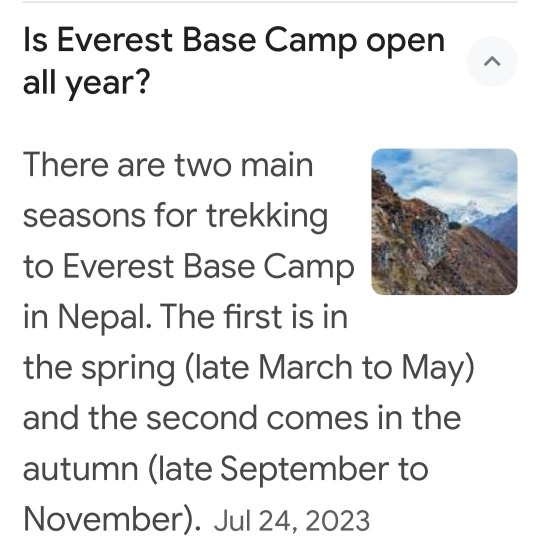
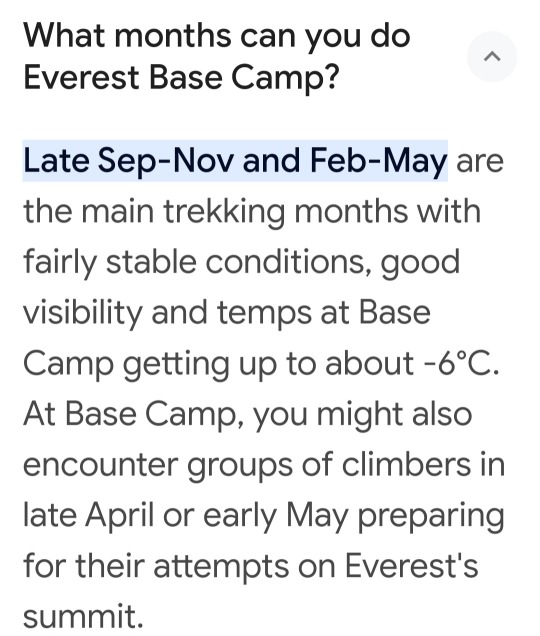
BUT, you don't simply hop on a plane and get plopped down at Base Camp's 17,000 feet altitude. You could quite literally die from High Altitude Cerebral Edema and or High Altitude Pulmonary Edema due to the low oxygen levels. Soooo, IF Sam wanted to trek to Mount Everest Base Camp in Nepal, he would have to start acclimating at least two weeks before. All travelers going from Nepal's capital, Kathmandu at an elevation of 4,344 feet stay there for a few days, and then they do a 14 day trek up the mountains, to allow their bodies to acclimate to the altitude and the lower oxygen levels. 👇
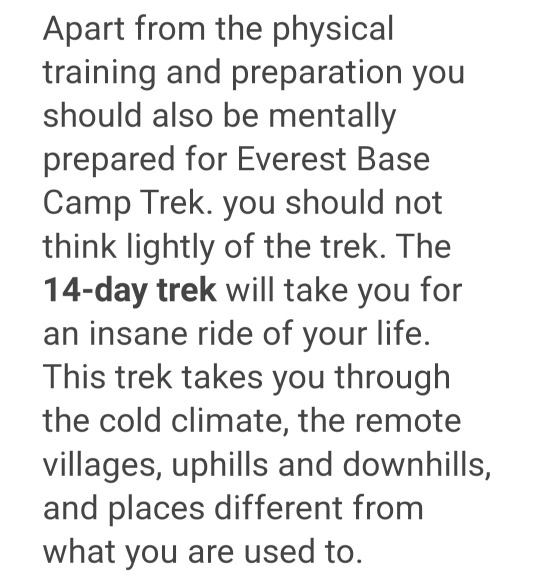
Sam would have to allow himself at LEAST 3 WEEKS to make the Everest Base Camp trek. 2 weeks to climb there and acclimate, and then you want to spend at least a week there camping and just being there. Then you have to allow time for the return climb back down. This isn't a weekend excursion.
As for whether Sam is actually trying to climb to Mount Everest SUMMIT. That would be a definite NO. Not only from an Outlander insurance and contract issue, but also because it's not summit climbing season. 👇

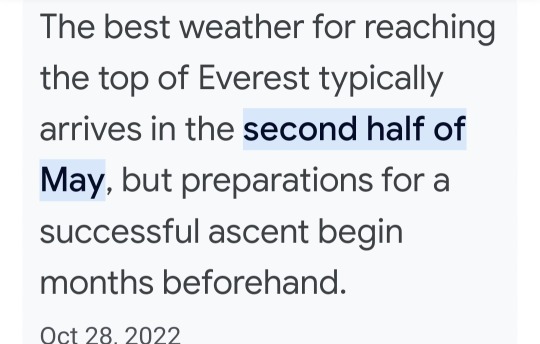
And for people who want to climb to the Summit, they have to make a 2 MONTH commitment. The summit climb entails the two weeks to climb to Base Camp. And then at least 6 weeks, climbing up and down from each of the higher camps. I think there are at least 4 camps that climbers stay at, higher and higher on the mountain, until they reach the Summit. 👇
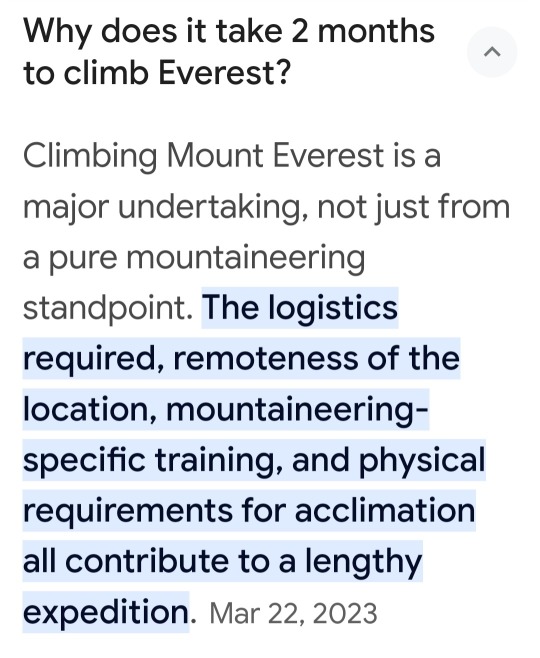
So, if a climber wants to go for a Summit bid, which is always in mid-May, they would have to start in mid-March and literally be on Mount Everest at the various camps the whole two months. It's a huge commitment. Most companies charge around $40,000 for the whole expedition. The reputable ones assign each climber a Sherpa to guide you. The Sherpas are natives to the area and they are expert climbers who are born in the area, therefore their bodies are completely acclimated to the high altitude. The expedition companies hire them to help climbers up the mountain. They set all the safety ropes, set up the camps, make the meals, and deal with the inevitable emergencies along the way. No one should climb without a Sherpa. Also, most companies will only take on a climber for a Summit bid if they can show previous experience in climbing at high altitude and have summitted a few of the highest peaks on Earth. That's not Sam. So, if anything, Sam would probably only be allowed to climb to Base Camp.
As you can see, I'm really, really into all things Everest and could keep writing all day hahaha. But, I'll stop here. I hope that was helpful info, Anon.
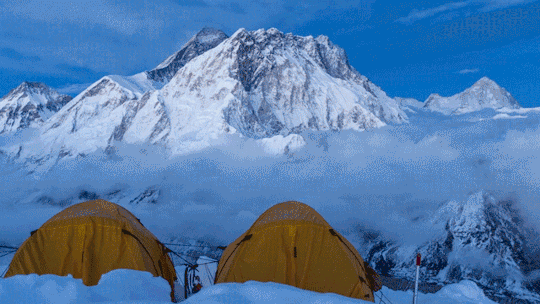
#samheughan#sam heughan#mount everest#everest#nepal#kathmandu#tibet#north side#south side#north face#south face#sherpas#base camp#everest base camp#summit#everest summit#outlander
59 notes
·
View notes
Text
Are you searching for the best off-the-beaten hiking trail in Nepal?






Look no further than the Tsum Valley trek, a remote and untouched paradise where few hikers venture, offering unparalleled tranquility and cultural richness.
Book our 14-day Tsum Valley trek in Nepal, guided by our experienced local experts and supported by reliable porters. Discover hidden monasteries, stunning landscapes, and rich cultural heritage in this serene Himalayan paradise.
Book now: https://www.glorioushimalaya.com/trip/tsum-valley-trek/
Contact us via email or WhatsApp for further information.
Email: [email protected] WhatsApp: +977-9813637616
#travel#tsum valley trek#trekking in Nepal#manslu region trek#hiking#adventure#mountains#himalayas#tours#walking tours#multi-day tours
3 notes
·
View notes
Text
How long does it take to climb Manaslu?
The eighth-highest peak in the world, Manaslu, is a spectacular climb. Standing at a height of 8,163 meters (26,781 ft), it is situated in Nepal. You may be wondering how long it takes to reach the top if you're considering taking on this adventure. Now let's dissect it!
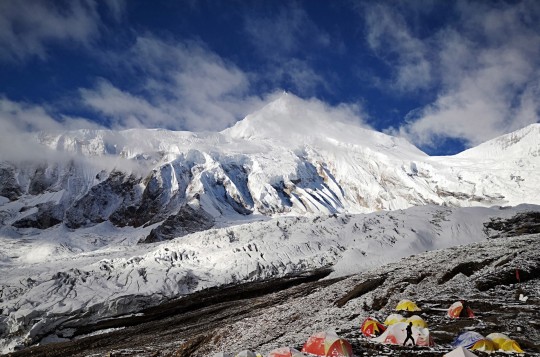
Preparation: Training and Planning
It's important to prepare before you ever set foot on the mountain. The majority of climbers train their bodies and minds for several months. Typically, this comprises:
Physical Training: Building strength, endurance, and flexibility.
Mental Preparation: Developing the mental toughness to handle extreme conditions.
Logistics: Organizing permits, gear, and a reliable guiding service.
Journey to Base Camp
Travel to Kathmandu, the capital of Nepal, is the first leg of the trek to Manaslu Base Camp. You will next drive to the trailhead, which is usually in Soti Khola or Arughat. This is a six to seven-hour drive. After that, you'll journey through stunning communities and scenery for roughly six to ten days. Acclimatization, or assisting your body in adjusting to the altitude, is facilitated by this walk.
Acclimatization and Climbing
Once at Base Camp, the real adventure begins. Here's a rough timeline:
Week 1: Base Camp and Acclimatization
Days 1-3: Setting up Base Camp and resting.
Days 4-7: Acclimatization hikes to higher altitudes and returning to Base Camp.
Weeks 2-3: Climbing Rotations
Days 8-14: Climbing to higher camps (Camp 1, Camp 2, Camp 3) and returning to Base Camp for rest. This helps your body get used to the thin air.
Days 15-21: More rotations between camps, gradually moving higher each time.
Week 4: Summit Push
Days 22-28: Weather permitting, you make your summit push. This involves:
Climbing from Base Camp to Camp 1, then Camp 2, Camp 3, and finally Camp 4.
From Camp 4, you'll start your summit attempt, often in the early hours before dawn. The climb from Camp 4 to the summit and back to a lower camp can take about 12-18 hours.
Descent and Return
Although the descent is faster after reaching the summit, caution is still necessary. Usually, returning to Base Camp takes three to four days. After spending another five to seven days trekking from Base Camp to the trailhead, one can drive back to Kathmandu.
Total Time
In total, the entire expedition from Kathmandu and back usually takes around 6-8 weeks. This includes time for acclimatization, climbing rotations, and weather delays.
Personal Experience
The experience of climbing Manaslu was both thrilling and draining. There were breathtaking vistas and hospitable residents along the route to Base Camp. Although difficult, the acclimatization climbs were necessary to help the body adjust to the high altitude. The most difficult part was pushing to the summit while dealing with bitter cold and strong gusts. It was all worthwhile, though, as you stood atop the peak and gazed down at the world below.
Final Thoughts
Manaslu climbing is a challenging but worthwhile experience. It calls for endurance, patience, and careful planning. Manaslu presents a special challenge that will make you cherish your time spent there, regardless of your level of experience as a mountaineer or your level of desire for exploration.
2 notes
·
View notes
Text
Everest Cho la pass Trek
The Chola Pass trek is another challenging and rewarding trekking route in the Everest region of Nepal. This trek usually takes around 14-16 days to complete and involves crossing the high altitude Chola Pass, which stands at an elevation of around 5,420 meters (17,782 feet). https://rb.gy/c4ash5 The trek to Chola Pass usually combines elements of the Everest Base Camp trek and the Gokyo Lakes trek, offering trekkers a unique and diverse experience. Along the way, trekkers can enjoy breathtaking views of the Himalayas, including Mount Everest, Cho Oyu, Lhotse, and others. It's important for trekkers to be well-prepared for high altitude and changing weather conditions when attempting the Chola Pass trek.
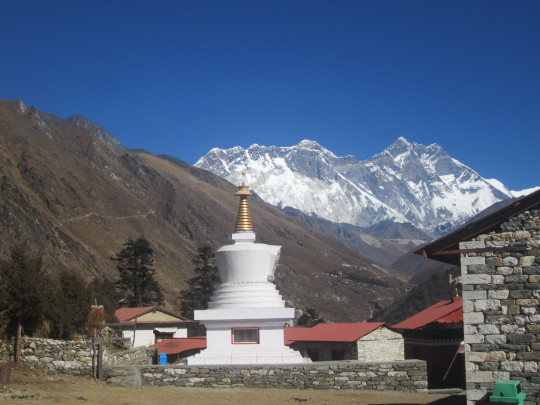
2 notes
·
View notes
Text
2 notes
·
View notes
Text
Everest Base Camp Trek - Conquer the Roof of the World!
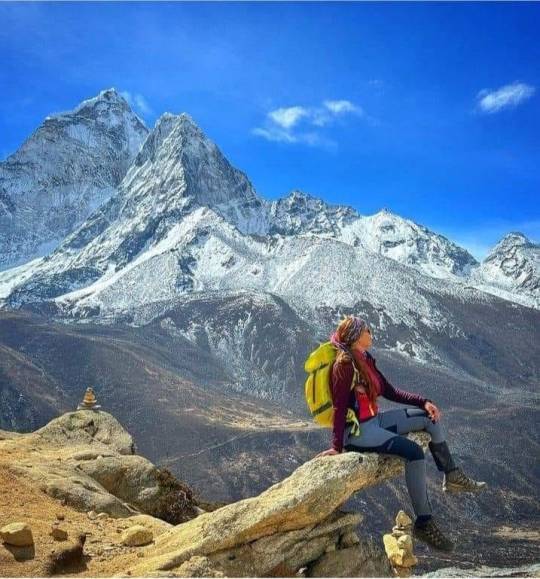
🏔️ 📅 Trip Duration: 14 days
📍 Destination: Nepal
🏞️ Trip Difficulty: Strenuous
🚍 Transport: Kathmandu - Lukla - Kathmandu
🍽️ Meals: Breakfast, Lunch & Dinner (BLD) during the trek 🏠
Accommodation: Cozy Teahouses & Lodges
👥 Group Size: Small & Personalized (Min. 1 / Max. 15)
⛰️ Max Elevation: 5,364m - Everest Base Camp
⏰ Walking Hours: 5-7 hours daily
🏁 Start/End: Kathmandu/Kathmandu
🚶♂️ Trekking Type: Local Lodge-based Tea House Trek
🌈 Best Season: February to May, September to December
🌟 TRIP HIGHLIGHTS
Trek to the base camp of the world's highest mountain, Mount Everest.
Experience the breathtaking beauty of the Khumbu region.
Witness stunning panoramic views of Everest, Lhotse, Nuptse, and more.
Explore the Sherpa culture and traditions in mountain villages.
Visit the famous Tengboche Monastery and receive blessings for a successful trek.
Travel with a small group for an intimate and personalized experience.
📋 DETAILED ITINERARY
Day 1: Arrival in Kathmandu Arrive in Kathmandu,
the bustling capital of Nepal. Meet your trekking guide and fellow adventurers. Rest and prepare for the exciting journey ahead.
Day 2: Flight to Lukla, Trek to Phakding (2,651m)
Take a thrilling flight to Lukla, the gateway to the Everest region. Embark on the trek to Phakding, passing through picturesque landscapes.
Day 3: Trek to Namche Bazaar (3,440m)
Continue the trek along the Dudh Koshi River. Climb up to Namche Bazaar, the vibrant Sherpa trading hub.
Day 4: Acclimatization Day in Namche Bazaar
Acclimatize to the increasing altitude in Namche Bazaar. Explore the town and enjoy panoramic views of Everest and surrounding peaks.
Day 5: Trek to Tengboche (3,867m)
Trek through rhododendron forests and reach the Tengboche Monastery. Experience the serene ambiance and panoramic mountain vistas.
Day 6: Trek to Dingboche (4,260m)
Descend to Debuche and cross the Imja River. Climb uphill to Dingboche, a beautiful village surrounded by mountains.
Day 7: Acclimatization Day in Dingboche
Take a day to acclimatize in Dingboche. Hike to Nagarjun Hill for breathtaking views of Ama Dablam and Lhotse.
Day 8: Trek to Lobuche (4,930m)
Trek through the moraines of the Khumbu Glacier. Reach Lobuche, a popular stop before reaching Everest Base Camp.
Day 9: Trek to Everest Base Camp (5,364m) and Gorak Shep (5,140m)
Ascend to the ultimate destination, Everest Base Camp. Witness the majestic Khumbu Icefall and the towering Everest. Descend to Gorak Shep for overnight stay.
Day 10: Hike to Kala Patthar (5,545m),
Trek to Pheriche (4,371m) Early morning hike to Kala Patthar for a stunning sunrise view over Everest. Descend to Pheriche, another beautiful Sherpa village.
Day 11: Trek to Namche Bazaar Trek back to Namche Bazaar,
enjoying the scenic landscapes. Relax and celebrate the successful completion of the trek.
Day 12: Trek to Lukla Continue the trek to Lukla,
the last leg of the journey. Reflect on the incredible adventure and bid farewell to the mountains.
Day 13: Flight to Kathmandu Fly back to Kathmandu and transfer to your hotel. Rest and celebrate the achievement of reaching Everest Base Camp.
Day 14: Departure Say goodbye to Nepal,
carrying with you unforgettable memories. Depart with a sense of accomplishment and a love for the Himalayas.
💰 COST INCLUDES
Airport transfers upon arrival and departure.
Domestic flights (Kathmandu - Lukla - Kathmandu) with airport taxes.
Accommodation in a 3-star hotel in Kathmandu with breakfast.
Tea house or lodge accommodation during the trek.
All meals (Breakfast, Lunch & Dinner) during the trek.
Licensed English-speaking trekking guide.
Porter service (1 porter for 2 trekkers) to carry your trekking gear.
Sagarmatha National Park Entry Permit.
TIMS card (Trekker's Information Management System).
All government taxes and official expenses.
🚫 COST EXCLUDES
International airfare to and from Kathmandu.
Nepal entry visa fees (available upon arrival at Kathmandu airport).
Travel and rescue insurance (mandatory).
Personal expenses such as additional meals, drinks, and snacks.
Tips for trekking staff (guide, porter, etc.).
Any extra costs incurred due to unforeseen circumstances (natural disasters, flight delays, roadblocks, etc.).
Any services not mentioned in the "Cost Includes" section.
🗨️ FOR MORE INFORMATION AND BOOKINGS, CONTACT US: Email: [email protected] WhatsApp: +977-9808262524
https://www.missionsummittreks.com/trip/everest-base-camp-trek/
🌄 Embark on a journey to conquer Everest Base Camp! 🌄
2 notes
·
View notes
Text
The Ultimate Guide to Mount Everest: A Journey to the Top of the World
Mount Everest, the highest peak on Earth, stands at a staggering 8,848.86 meters (29,031.7 feet) above sea level. Located in the Himalayas, it straddles the border between Nepal and Tibet, making it a dream destination for adventurers and trekkers worldwide. Whether you are a seasoned mountaineer or an enthusiast planning to witness its grandeur, this guide will help you explore everything about Everest, from its history to the best ways to experience it.
A Brief History of Mount Everest
Mount Everest, known as Sagarmatha in Nepal and Chomolungma in Tibet, has fascinated explorers for centuries. It was first summited on May 29, 1953, by Sir Edmund Hillary from New Zealand and Tenzing Norgay, a Sherpa from Nepal. Since then, thousands of climbers have attempted to reach its peak, facing extreme weather conditions, avalanches, and thin air.
Best Ways to Experience Mount Everest
You don’t have to be a professional climber to enjoy the beauty of Everest. Here are some of the best ways to experience it:
Everest Base Camp Trek (EBC)
One of the most popular trekking routes, the Everest Base Camp Trek takes you through picturesque Sherpa villages, lush forests, and breathtaking landscapes.
The trek typically takes 12-14 days and reaches a maximum altitude of 5,364 meters (17,598 feet).
Everest Scenic Flight
If trekking isn't for you, a scenic flight from Kathmandu offers a bird’s-eye view of Everest and surrounding peaks.
Flights operate early in the morning to ensure clear visibility.
Helicopter Tour to Everest Base Camp
A luxury alternative to trekking helicopter tour takes you close to Everest and lands at Kala Patthar (5,545 meters/18,192 feet) for an up-close experience.
Gokyo Lakes Trek
This trek offers an alternative to EBC, leading to the stunning Gokyo Lakes and providing panoramic views of Everest without the crowds.
Best Time to Visit Everest
The best seasons for trekking and expeditions to Everest are:
Spring (March-May) – Stable weather, blooming rhododendrons, and optimal climbing conditions.
Autumn (September-November) – Clear skies and moderate temperatures, making it ideal for trekking.
Essential Tips for Everest Trekkers
Prepare for Altitude Sickness: Acclimatization days are essential to avoid altitude sickness.
Pack Wisely: Layered clothing, waterproof gear, and sturdy boots are a must.
Train Beforehand: Improve your endurance with cardio and strength training.
Respect the Local Culture: Sherpas and locals have deep-rooted traditions—respect them during your journey.
Plan Your Mount Everest Adventure with Nepal Horizon Treks!
Whether you're dreaming of trekking to Everest Base Camp or witnessing its majestic peak from the sky, Nepal Horizon Treks can turn your adventure into reality. With expert guides, tailored itineraries, and a commitment to safety, we ensure an unforgettable experience in the Himalayas.
👉 Book your Everest trek today with Nepal Horizon Treks!
Mount Everest is more than just a mountain—it’s an adventure of a lifetime. Are you ready to explore it? 🚀
0 notes
Text
#everest base camp trek#everest base camp trek 14 days#everest base camp trek itinerary#everest base camp trek package#nepal everest base camp trek#annapurna circuit trek#annapurna hike#annapurna trek package#annapurna circuit trek itinerary#annapurna base camp trek#annapurna base camp trek cost#annapurna base camp trek map#annapurna base camp#manaslu circuit trek#manaslu circuit trek 12 days#manaslu base camp trekking#manaslu circuit trek package#mardi himal trek#mardi himal trek cost#mardi trek itinerary#mardi himal trek package
0 notes
Text
Upper Mustang Trek Guide: Exploring the Forbidden Kingdom

Tucked away in the rain shadow of the Himalayas, the Upper Mustang Trek is a journey into a mystical, arid landscape that feels like stepping back in time. Often referred to as the "Forbidden Kingdom," Upper Mustang was once a restricted region, preserving its unique Tibetan culture, ancient monasteries, and dramatic landscapes. My trek through this remote and enchanting region was an unforgettable adventure. Here’s everything you need to know to plan your own journey to Upper Mustang.
Why Upper Mustang?
Upper Mustang is a rare gem in Nepal, offering a unique blend of stark desert-like landscapes, rich Tibetan culture, and a sense of untouched authenticity. The region’s isolation has kept its traditions alive, making it a fascinating destination for trekkers seeking something different from the lush greenery of other Nepalese trails.
The trek takes you through ancient walled cities, cave monasteries, and dramatic canyons, with the backdrop of the Annapurna and Dhaulagiri ranges. It’s a trek that combines adventure, culture, and history in one unforgettable package.
The Journey Begins: Kathmandu to Pokhara to Jomsom
The adventure starts in Kathmandu, where you’ll obtain the necessary permits for Upper Mustang (a restricted area permit is required). From Kathmandu, take a flight or drive to Pokhara, Nepal’s lakeside city and the gateway to the Annapurna region.
From Pokhara, a short flight takes you to Jomsom, a windy town in the Kali Gandaki Valley. Alternatively, you can trek to Jomsom via the Annapurna Circuit. Jomsom is the starting point for the Upper Mustang Trek.
Trekking Through the Forbidden Kingdom
The Upper Mustang Trek typically takes 10-14 days, depending on your itinerary. Here’s a breakdown of the key stages:
Day 1-2: Jomsom to Kagbeni to Chele
The trek begins with a walk to Kagbeni, a picturesque village with narrow alleys and a medieval feel. Kagbeni is the gateway to Upper Mustang and the last village before the restricted area.
From Kagbeni, the trail ascends to Chele, offering your first glimpse of the arid landscapes that define Upper Mustang.
Day 3-4: Chele to Syangboche to Ghami
The trail winds through dramatic canyons, rocky cliffs, and small villages. You’ll pass through Syangboche, a charming village with a stunning view of Nilgiri Peak.
Ghami, one of the largest villages in Upper Mustang, is known for its ancient monastery and long mani walls (stone walls carved with Buddhist prayers).
Day 5-6: Ghami to Tsarang to Lo Manthang
The trek to Tsarang takes you through more arid landscapes, with views of the distant Himalayas. Tsarang is home to a beautiful monastery and a ruined palace.
Finally, you’ll reach Lo Manthang, the capital of Upper Mustang. This walled city is the cultural and historical heart of the region, with its royal palace, ancient monasteries, and traditional Tibetan architecture.
Day 7-8: Exploring Lo Manthang
Spend a couple of days exploring Lo Manthang and its surroundings. Visit the Royal Palace, the Thubchen and Chhoede monasteries, and the nearby cave monasteries like Lo Gekar and Jhong.
You can also take a day trip to the northern villages of Chhoser and Namgyal, known for their caves and stunning views.
Day 9-12: Lo Manthang to Jomsom
The return journey follows a different route, taking you through the villages of Yara, Tangye, and Chhusang. The landscapes remain dramatic, with deep canyons, red cliffs, and panoramic views of the Himalayas.
The trek ends back in Jomsom, where you can catch a flight to Pokhara.
Key Highlights of the Trek
Lo Manthang: The walled city is the cultural and historical heart of Upper Mustang, with its royal palace, monasteries, and traditional Tibetan architecture.
Cave Monasteries: Explore ancient cave monasteries like Lo Gekar and Jhong, which are steeped in history and spirituality.
Dramatic Landscapes: The arid, desert-like landscapes of Upper Mustang are unlike anything else in Nepal, with deep canyons, red cliffs, and panoramic views of the Himalayas.
Tibetan Culture: The region’s strong Tibetan influence is evident in its monasteries, prayer flags, and traditional way of life.
Permits and Logistics
Restricted Area Permit: Upper Mustang is a restricted area, and you’ll need a special permit (USD 500 for 10 days).
Annapurna Conservation Area Permit (ACAP): This permit is also required for the trek.
Guided Trek: You must trek with a licensed guide, as independent trekking is not allowed in Upper Mustang.
Best Time to Trek
The best time to trek in Upper Mustang is during the spring (March to May) and autumn (September to November) seasons. These months offer stable weather, clear skies, and comfortable temperatures.
Challenges and Rewards
The Upper Mustang Trek is considered moderate in difficulty, with long walking days and high altitudes (up to 4,000 meters / 13,123 feet). The arid climate and dusty trails can be challenging, but the rewards far outweigh the difficulties. The unique landscapes, rich culture, and sense of adventure make it a truly unforgettable experience.
Reflections on the Journey
The Upper Mustang Trek was a journey into a world that felt both ancient and timeless. The stark beauty of the landscapes, the warmth of the local people, and the rich cultural heritage left a lasting impression. It reminded me of the importance of preserving these remote and fragile regions, and the incredible beauty of our planet.
If you’re looking for a trek that combines adventure, culture, and history, the Upper Mustang Trek is the perfect choice. It’s a journey that will challenge you, inspire you, and stay with you long after you’ve returned home.
0 notes
Text
Everest Region Trekking: An Unforgettable Journey to the Roof of the World
If there’s one trek that captures the imagination of adventurers, it’s the journey to the Everest Region in Nepal. Renowned for its awe-inspiring landscapes, vibrant Sherpa culture, and, of course, the towering presence of Mount Everest—the tallest peak in the world—this trekking destination has become a bucket-list experience for hikers from all corners of the globe.
In this blog, we’ll take you on a journey through the Everest Region trekking, offering insights into the routes, the trekking experience, the best time to visit, and the cultural treasures you’ll encounter along the way.

A Glimpse of the Everest Region
The Everest Region, located in the northeastern part of Nepal, is part of the Sagarmatha National Park, a UNESCO World Heritage Site. The region is not only home to Mount Everest (8,848.86 meters), but also to several other majestic peaks like Lhotse, Makalu, and Cho Oyu. The trekking routes here offer a blend of challenges, breathtaking landscapes, and glimpses into the way of life of the Sherpas, who call this region home.
There are several trekking routes in the Everest Region, ranging from moderate hikes to challenging expeditions, each offering unique views of the surrounding peaks, glaciers, and deep valleys. The most popular trekking route is the Everest Base Camp Trek, but there are also options for trekking to Gokyo Lakes, the Three Passes Trek, and the Everest View Trek.
Everest Base Camp Trek: A Once-in-a-Lifetime Experience
The Everest Base Camp Trek is undoubtedly the most famous trail in the region, attracting thousands of trekkers each year. It’s a moderate-to-strenuous trek, typically lasting 12-14 days, depending on your pace and acclimatization needs.
Day 1: Lukla to Phakding
The adventure begins with a flight from Kathmandu to Lukla, a small airport perched on a mountain ledge. From Lukla, you’ll trek to Phakding, passing through small villages and crossing suspension bridges that span the Dudh Koshi River.
Day 2-3: Phakding to Namche Bazaar
The next phase of the trek leads to Namche Bazaar, the gateway to the Khumbu region. This vibrant town is a hub of activity, where you’ll find markets, lodges, and bakeries. It’s also an ideal place to acclimatize before heading further up. Namche offers stunning views of Everest, Lhotse, and Ama Dablam, and it’s here that you can explore the Sherpa Museum and the nearby Everest View Hotel.
Day 4-5: Namche Bazaar to Tengboche
From Namche, the trail continues through dense forests of pine and rhododendron, offering spectacular views of the surrounding peaks. The climb to Tengboche is rewarded with a visit to the famous Tengboche Monastery, one of the most important Buddhist monasteries in the region. The view of Mount Everest from here is unforgettable, especially during sunrise when the golden light bathes the snow-covered peaks.
Day 6-7: Tengboche to Dingboche
As you trek higher, the landscape changes, becoming more rugged and barren. Dingboche is a beautiful village at the foot of Island Peak, and it serves as a great place to acclimatize further. From here, the views of the Khumbu Icefall and the surrounding peaks become even more dramatic.
Day 8-9: Dingboche to Gorak Shep
The final push towards Everest Base Camp begins with the trek to Gorak Shep, a small settlement near the base of the mountain. From Gorak Shep, it’s a short hike to Everest Base Camp itself, where you’ll stand at the foot of the world’s highest peak and take in the mesmerizing views of glaciers and towering mountains. For many trekkers, reaching Everest Base Camp is the culmination of years of dreaming and preparation.
Day 10-11: Gorak Shep to Lukla
After spending time at Base Camp, it’s time to head back down. The trek back to Lukla is easier, though still physically demanding. Along the way, you’ll have the opportunity to reflect on the incredible journey you’ve just completed.
Best Time for Everest Region Trekking
The Everest Region is accessible year-round, but the best times to trek are during the spring (March to May) and autumn (September to November). During these seasons, the weather is generally stable, with clear skies and moderate temperatures. The days are sunny and warm, while the nights can be cold, especially at higher altitudes.
Summer (June to August) brings monsoon rains, making the trails slippery and challenging. Winter (December to February) can be bitterly cold, with heavy snowfalls that may close some routes, but it offers a quieter and less crowded trekking experience.
Cultural Insights Along the Way
Trekking in the Everest Region is not just about the stunning scenery—it’s also about immersing yourself in the rich Sherpa culture. As you trek through the villages, you’ll encounter friendly locals, visit traditional Buddhist monasteries, and learn about the unique way of life in the Khumbu Valley.
Namche Bazaar, Tengboche, and Dingboche are some of the best places to explore Sherpa culture. Here, you can visit monasteries, interact with locals, and sample traditional Sherpa cuisine, such as momo (dumplings) and dal bhat (lentil soup with rice).
Physical Preparation for Everest Region Trekking
While the Everest Base Camp Trek is not a technical climb, it’s still physically demanding, especially at higher altitudes. Acclimatization is crucial to avoid altitude sickness, so it’s important to take rest days and ascend slowly. Training for the trek should include cardiovascular exercises, strength training, and hiking with a loaded backpack to build stamina.
It’s also essential to bring the right gear. Layered clothing, sturdy trekking boots, a good-quality sleeping bag, and a down jacket for the cold nights are all necessary for the journey.
Secondary Keywords: Everest Base Camp Trek, Sherpa culture, trekking in Nepal, Himalayan adventure, Gokyo Lakes trek, Three Passes Trek, altitude sickness, trekking preparation, mountain trekking in Nepal
Final Thoughts
Everest Region trekking is more than just a physical challenge; it’s an opportunity to experience the majesty of the Himalayas, the resilience of the people who live in its shadow, and the deep sense of accomplishment that comes with standing at the foot of Mount Everest.
Whether you’re embarking on the classic Everest Base Camp Trek, exploring the serene Gokyo Lakes, or taking on the challenging Three Passes Trek, the Everest Region offers a once-in-a-lifetime adventure that will stay with you forever.
So, are you ready to take that first step towards the Roof of the World? The adventure of a lifetime awaits!
0 notes
Text
Exploring the Thrilling Adventure of Manaslu Base Camp Trek
Introduction For those seeking a raw and untouched trekking experience, the Manaslu Base Camp Trek is a perfect choice. This journey takes adventurers through remote trails, offering stunning views of snow-capped peaks, diverse landscapes, and cultural immersion. Guided by a professional Nepal trekking tour operator, travelers can navigate the high-altitude trails safely while experiencing the beauty of the Himalayas.
The Allure of Manaslu Base Camp Trek Nestled in the heart of the Himalayas, this trek leads to the base of the world's eighth-highest peak, Mount Manaslu (8,163m). Unlike the crowded trails of Everest and Annapurna, this region remains relatively untouched, offering an authentic wilderness experience. The trek passes through lush forests, terraced fields, glacial rivers, and high mountain passes, providing an ever-changing landscape.
Trekkers will encounter the rich culture of ethnic communities, including the Gurungs and Tibetans, who have preserved their traditions for centuries. Ancient monasteries, chortens, and prayer flags fluttering in the mountain breeze add a spiritual essence to the journey.
Best Time to Embark on the Journey The best time for this trek is during the spring (March to May) and autumn (September to November). These seasons provide stable weather conditions, clear skies, and breathtaking mountain views. Winter trekking is also possible but requires extra preparation due to extreme cold and heavy snowfall.
The Challenging Yet Rewarding Trek The Manaslu Base Camp Trek is considered a moderately challenging adventure, requiring a good level of fitness and acclimatization. The journey typically takes around 14 to 18 days, covering diverse terrains, suspension bridges, and steep ascents. The highest point of the trek, Larkya La Pass (5,160m), offers panoramic views of Himalayan giants, making the effort worthwhile.
Travelers often rely on a trusted Nepal trekking tour operator to ensure a smooth and well-organized expedition. From securing permits to arranging accommodations in teahouses along the route, professional guidance enhances the trekking experience.
Unique Highlights of the Trek Crossing the Larkya La Pass, one of the most spectacular Himalayan passes. Exploring the remote villages of Samagaun and Samdo, rich in Tibetan-influenced culture. Witnessing the breathtaking beauty of Birendra Lake and glacial valleys. Trekking through the Manaslu Conservation Area, home to diverse flora and fauna. Experiencing warm hospitality from locals in traditional mountain settlements.
Essential Preparation for the Trek Proper preparation is key to completing this adventure successfully. Trekkers should engage in cardiovascular and strength training exercises before the journey. Essential gear includes thermal clothing, a good-quality sleeping bag, trekking poles, and sturdy boots. Hydration, acclimatization, and proper nutrition play a crucial role in preventing altitude sickness.
Conclusion The Manaslu Base Camp Trek is a journey of a lifetime, blending adventure, culture, and natural beauty into one remarkable experience. Whether you are an experienced trekker or someone looking to explore the untouched trails of the Himalayas, this trek promises breathtaking landscapes and unforgettable memories. With careful preparation and the support of expert guides, this adventure will undoubtedly be one of the most rewarding experiences in the great Himalayan wilderness.
0 notes
Text

Group Joining Dates Open for Everest Base Camp Trek 2025
Group Joining Dates Open for Everest Base Camp Trek 2025
Join in our 14 Days 𝐄𝐯𝐞𝐫𝐞𝐬𝐭 𝐁𝐚𝐬𝐞 𝐂𝐚𝐦𝐩 𝐓𝐫𝐞𝐤 𝟐𝟎𝟐𝟓 – An Adventure of a Lifetime with Glorious Himalaya Team- A Locally Owned Trekking Company in Nepal.
Experience the 𝐇𝐢𝐦𝐚𝐥𝐚𝐲𝐚𝐬 like never before!
𝐖𝐡𝐲 Glorious Himalaya for your EBC Trek? 𝐀𝐰𝐚𝐫𝐝-𝐖𝐢𝐧𝐧𝐢𝐧𝐠 𝐒𝐞𝐫𝐯𝐢𝐜𝐞: Awarded by Tripadvisor Travelers’ choice award. Safety First: Comprehensive safety measures to ensure a secure trekking experience. Experienced Team: Our knowledgeable local guides and porters who prioritize your safety and enjoyment. Hassle-Free Planning: We handle all logistics, so you can focus on the adventure. 𝐒𝐦𝐚𝐥𝐥 𝐆𝐫𝐨𝐮𝐩𝐬: Specializing in smaller group tours with personalized service. Note: Private groups’ departures are available at any dates throughout the year
𝐀𝐯𝐚𝐢𝐥𝐚𝐛𝐥𝐞 joining 𝐃𝐚𝐭𝐞𝐬 for 𝟐𝟎𝟐𝟓! Plan your adventure with us for a truly memorable trek. .
𝐎𝐔𝐑 GROUP JOINING 𝐃𝐀𝐓𝐄𝐒 𝐅𝐎𝐑 𝐒𝐏𝐑𝐈𝐍𝐆 𝟐𝟎𝟐𝟓: 7th March - 20th March (Group Joining available) 14th March - 27th March (Group Joining available) 4th April - 17th April (Group Joining available) 15th April - 28th April (Group Joining available) 6th May - 19th May (Group Joining available) 14th May - 27th May (Group Joining available)
𝐎𝐔𝐑 GROUP JOINING 𝐃𝐀𝐓𝐄𝐒 𝐅𝐎𝐑 𝐀𝐔𝐓𝐔𝐌𝐍 𝟐𝟎𝟐𝟓: 9th September – 22nd September (Group Joining available) 15th September - 28th September (Group Joining available) 5th October - 18th October (Group Joining available) 17th October - 30th October (Group Joining available) 4th November - 17th November (Group Joining available) 16th November - 29th November (Group Joining available)
TOUR FACTS Total Duration: 14 Days Total walking days: 11 Days Group size: 2-8 Pax Maximum Altitude: 5600 meters Trip Grade: Moderate to Challenging
TREK OUTLINE ITINERARY Day 1: Arrival in Kathmandu Day 2: Fly to Lukla and trek to Phakding Day 3: Trek to Namche Bazaar Day 4: Acclimatization day Day 5: Trek to Tenbgoche/Deboche Day 6: Trek to Dingboche Day 7: Rest day Day 8: Trek to Lobuche Day 9: Trek to Everest base camp/ Gorakshep Day 10: Hike Kalapatthar and trek to Pheriche Day 11: Trek to Namche Bazaar Day 12: Trek to Lukla Day 13: Fly back to Ramechhap/Kathmandu Day 14: Departure from Nepal
Reserve your spot now 𝐚𝐧𝐝 𝐛𝐞 𝐩𝐚𝐫𝐭 𝐨𝐟 𝐚𝐧 epic 𝐄𝐯𝐞𝐫𝐞𝐬𝐭 𝐁𝐚𝐬𝐞 𝐂𝐚𝐦𝐩 journey 𝐰𝐢𝐭𝐡 local expert !
Book now and secure your place and transform your trekking dreams into reality!
#trekking in nepal#everest#everest base camp trek#everest hike#ebc trek#hiking#adventure#himalayas#travel#tours#guided hike#multi day tours
1 note
·
View note